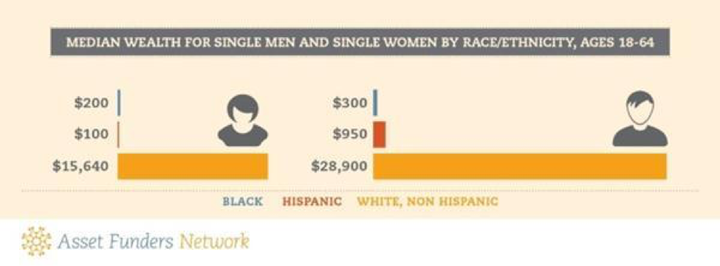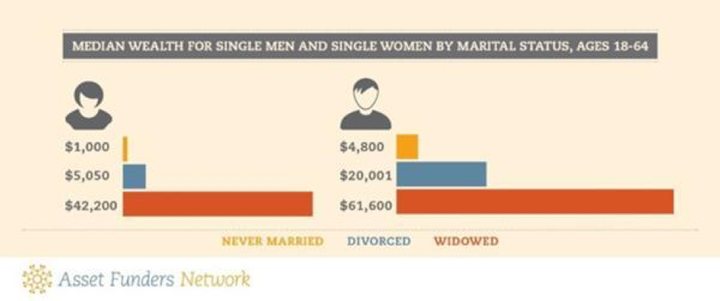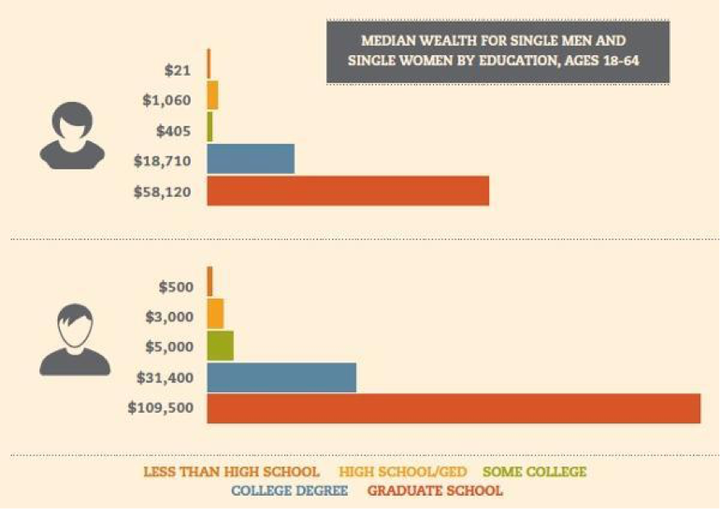
By Anna Mahathey
In 2016 women still make an average of only 79 cents for every dollar earned by a white man. The data are even more disheartening when broken down along racial lines. Although income disparities are grave, our quest for gender equity must not stop at closing the wage gap. Even more troubling is another gap that fewer people know about, but which gapes even wider: the gender wealth gap.
On average, single women own a mere 32 cents for every dollar that single men own. That gap is even greater broken down by race, with single African-American and Latina women owning less than one cent for every dollar owned by single white men.

So, how do women build wealth differently than men, and why is the gap so big? Part of the difference results from the type of employment women are more likely to hold. Today, 57 percent of women work in the paid labor force (compared to only 43 percent in 1970) and now comprise nearly half of the labor force. Two-thirds of working women today are the sole, primary or co-breadwinners of their household (rock on, women!). While women have made tremendous gains in overall workforce participation—especially since the recession ended in 2009—60 percent of those gains are in the ten largest low-wage jobs in America, including positions as childcare workers, housecleaners and bartenders. Women’s low-wage employment points toward a nationwide trend of a gendered division of labor. An employee working full-time in low-wage sectors may earn only $15,000 annually and often doesn’t have the financial means to build wealth after paying for basic necessities.
Furthermore, employees in the low-wage sector lack access to what gender wealth gap expert Mariko Chang calls the “wealth escalator.” Through employer-related fringe benefits, favorable tax breaks and government benefits, the wealth escalator enables people, mostly men, to transform income into wealth much quicker than they could simply by saving. For that reason, the type of employment women hold really matters, especially for African-American and Latina women who are more disproportionately represented in the low-wage service sector, which tends to offer few employer-provided benefits.
Unfortunately, even in higher-wage positions where women have greater access to the wealth escalator, traditional expectations of women's roles in the workforce and at home prevent them from building as much wealth as men. In fact, never-married women fare worse in wealth accumulation than any other household type. For African-American women, who are less likely to marry and more likely to be single mothers, the wealth disparities are severe.

Regardless of race, many mothers face the "motherhood penalty" in the workplace. Low-wage working mothers see their wages decrease seven percent for each child they have. That’s one reason mothers tend to have low wealth, owning just 20 percent of the wealth that fathers do. Women are still the primary caregivers for 61 percent of U.S. households; even beyond childcare, women tend to take on caregiving responsibilities for elderly parents, sick relatives and others. Because of that, the average woman spends 12 years out of the paid workforce to care for family. Having an inconsistent work history because of their caretaker role not only gives women inconsistent income but also hampers their ability to save and contribute to retirement plans, leaving women 80 percent more likely to live in conditions of poverty by the time they’re 65.
The gender wealth gap grows exponentially as education increases. Due to student loan debt, millennial women are hit particularly hard and have zero wealth, on average.

So what does all of this mean for women’s wealth? It means that income is important, but closing the gender wage gap won’t close the gender wealth gap. Our solutions must be more holistic and comprehensive in a way that regards the values of womanhood in the home and in the workplace. Policy changes can conquer the wealth gap. To help protect and build women’s economic security, Congress should:
Expand the Saver’s Credit (S.2492) and make it fully refundable
Strengthen employer benefits, particularly in low-wage and part-time positions:
Access to retirement accounts: SAVE UP Act (H.R. 5731)
Increase the Child Tax Credit (H.R. 4693)
Readers, take an active step with me to close the women’s wealth gap by contacting your representatives and urging them to support the legislation above. Never forget that your voice does matter, and without it, we can’t create necessary and effective policy change.

Anna Mahathey is currently pursuing a dual degree in Masters of Public Policy/M.A. in Women’s, Gender, and Sexuality Studies at the Heller School for Social Policy and Management at Brandeis University. Her research and professional interests fall at the intersection of poverty, gender, and inequality. This article was adapted from a blog series she wrote during her summer internship at CFED (Corporation for Enterprise Development) in Washington, D.C. Read the original post here. She can be contacted at amahathey@brandeis.edu.